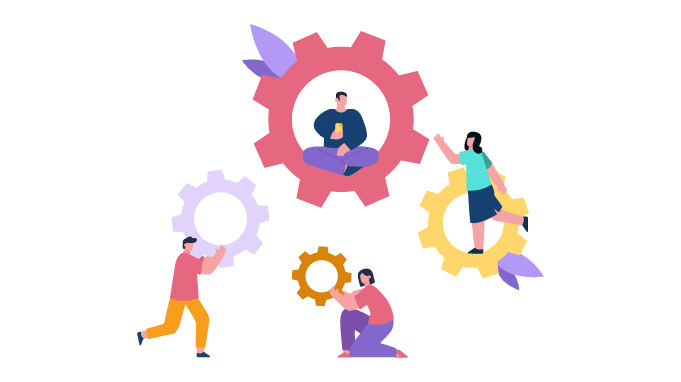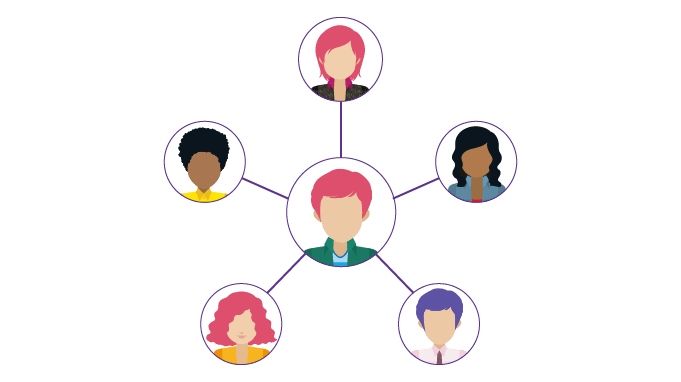10 of The Most Important Elements of Organizational Culture in 2023
Organizational culture is like the operating system that sets the tone across every aspect of a company.
It guides how people collaborate, make decisions, recognize achievements, and even decorate office spaces. Culture exists in the unwritten attitudes, subtle habits, and collective personalities woven into the fabric of a workplace.
When culture thrives, employees personally feel invested in the company’s purpose and community. But culture fails to materialize out of thin air. It takes deliberate action across the core elements that we are going to discuss in this article in detail and with some examples.
Key Insights
- Concept of Organizational Culture
- Core Elements of Organizational Culture
- Examples of Companies Incorporating These Elements
What is Organizational Culture?
Organizational Culture is defined as the underlying beliefs, assumptions, values, and ways of interacting that contribute to an organization's unique social and psychological environment.
The employees are expected to understand the culture of the company and be a part of it. Only to accomplish the company goals and missions together, believing and acting on the cultural values.
10 Elements of Organizational Culture
1. Values

A company's values reflect its highest priorities and ideals. They guide employees in decision-making when no policy or procedure applies. Studies show that employee retention increases by 5X when employees believe in leadership's values.
Values like integrity, customer service, collaboration, diversity and inclusion should be clearly defined and then integrated into every aspect of operations.
Example: Southwest Airlines values inclusion, generosity, humility, etc. They empower employees to make decisions that uphold these values.
While hiring, they assess potential candidates during interviews to ensure alignment with the company's values rather than focusing solely on the individual's values.
This practice not only minimizes employee turnover but also boosts overall job satisfaction. This has resulted in merely 1.5% of employees getting terminated, with only 2% opting to leave voluntarily.
2. Leadership

Leaders play an immense role in cultivating culture through their behaviors, attitudes, and communication styles. Transparent leaders shape organizational culture by engaging openly with employees and demonstrating ethical behavior and company values positively.
Additionally, leaders should take the necessary steps to strengthen culture. These steps include -
- Soliciting feedback,
- Explaining decisions,
- Being vulnerable about mistakes, and
- Highlighting employee stories.
Example: Sal Khan, the founder of Khan Academy, hosts weekly fireside chats and Q&As with employees to model transparency. His authenticity keeps the culture strong despite rapid growth.
3. Communication

Open and frequent communication ensures alignment across an organization and builds trust. Tools like Slack and Microsoft Teams have made constant communication the norm.
In the absence of trust in leadership, and credible and relevant communications from leadership, organizations run the risk of having more detractors than activists.
– Renee Austin (Weber Shandwick)
Example: Buffer, a social media marketing software company, is well-known for its internal communication to improve organizational culture.
Buffer places a significant emphasis on transparency, focusing on clear communication and avoiding assumptions.
This commitment is evident in the company's day-to-day practices, notably through the 'All Hands' meeting held monthly. This event includes a CEO and leadership team presentation for updates on headlines and performance.
Additionally, a meeting in the 'town hall' format provides all employees the chance to ask questions and stay informed.
By adopting a meeting format that promotes communication and engagement, they effectively mitigate the risk of individuals becoming bored and disengaged.
4. Recognition

Appreciation and recognition are vital for reinforcing positive behaviors and making employees feel truly valued for their contributions.
Timely employee recognition for achievements, demonstrating values, solving problems, strong collaboration, and milestones show alignment with cultural priorities. Both monetary and social recognition boost motivation and engagement.
As per a report, when employee recognition is done right, it boosts employee retention by a whopping 5X in the organization.
Example: Zappos, a subsidiary of Amazon, has an amazing employee recognition program. The program is based on peer-to-peer recognition. It aims to build a culture of appreciation among colleagues and a positive team spirit.
In order to make the program fun, they have coined the term ‘Zapponians’ for their employees. Their peer-to-peer programs include -
A. Zollar Program: Here, Zollars (or Zappos Dollars) can be earned by volunteering to help others, and they are then used to redeem merchandise from the Zollar Store.
B. Master of WOW Parking: Recognizes employees with a premium parking space through peer-to-peer acknowledgment.
C. Coworker Bonus Program: Allows employees to reward one another with a $50 coworker bonus.
5. Professional Development

You can never go wrong by investing in employees.
Investing in employees demonstrate that their development matters to the organization. It can be done through several initiatives, such as -
- Continuous learning and growth through training programs,
- Mentorship,
- Tuition assistance, and
- Internal mobility opportunities
Initiatives and opportunities like these provide a sense of progress and purpose to your employees.
Data shows that a striking 94% of employees express their willingness to remain with a company for a longer duration if the organization invests in their learning and development.
Train people well enough so they can leave. Treat them well enough so they don't want to.
– Richard Branson
Example: Chipotle, an American chain of fast casual restaurants, has bolstered its commitment to employee development. They have incorporated over 5,500 remote courses spanning diverse subjects such as business, tech, and wellness.
This initiative aims to foster an inclusive approach to career growth, contributing to Chipotle's vision of cultivating a workplace free from discrimination and inequality.
6. Physical Environment

Does physical layout of an office influence how people interact and feel at work?
The answer is “Yes,” It does.
The office layout, architecture, accessibility, safety, and aesthetics influence how people interact and feel at work.
Spaces designed intentionally around collaboration and company culture create a sense of belonging. Natural light and ergonomic furniture also boost productivity.
According to a study conducted by Savills UK, 65% of employees believe that changing the current office design to their ideal workplace would improve their productivity.
Example: The Domino's headquarters in Ann Arbor, Michigan, is truly impressive. Featuring a spacious and stylish design, the offices boast an expansive interior and ample kitchen space. Notably, the company goes the extra mile by providing a built-in art gallery and a petting zoo, creating a stress-relieving environment for employees.
7. Hiring & Onboarding

The process of recruitment is an essential component towards shaping the organizational culture.
You must thoughtfully select people who align with the company's mission and values. Then provide them with immersive onboarding experience rooted in culture. This process contributes towards boosting retention.
Again, retention leads to facilitating cultural continuity as an organization evolves. According to SHRM, employees who underwent a well-structured onboarding program were found to be 58% more likely to stay with the organization after three years.
Example: Netflix is dedicated to ensuring the success of its employees right from day one. The company embraces a "welcome home" approach, creating a sense of security and grounding for newcomers.
The orientation process delves into the company's culture and vision, strategically spreading insights at various points throughout the employee's learning journey.
Managers play a crucial role during onboarding by scheduling regular introductions with different teams, fostering a comprehensive integration process.
8. Wellbeing

When you prioritize employees' physical, mental, financial, and social health, it shows that they are valued by the company.
Comprehensive wellbeing initiatives boost resilience, creativity, and loyalty. Such initiatives include health insurance, 401k matching, mindfulness training, and mental health benefits.
Wellness is the complete integration of body, mind, and spirit – the realization that everything we do, think, feel, and believe has an effect on our state of well-being.
– Greg Anderson
Example: Johnson & Johnson, with a workforce of 130 thousand across over 60 countries, has emerged as a trailblazer in promoting the health of its employees.
The commitment to well-being is seamlessly integrated into the company's physical environment and daily activities. This ranges from offering healthy eating guidance in the canteens to providing fitness centers with lunchtime classes, ensuring the well-being message permeates every aspect of the organization.
9. Diversity & Inclusion

Diversity may be the hardest thing for a society to live with and perhaps the most dangerous thing for a society to be without.
– William Sloane Coffin Jr.
Celebrating diverse backgrounds and perspectives creates psychological safety and a sense of belonging.
While hiring for diversity is crucial, inclusion must be embedded across the employee lifecycle. It can be done through fair policies, anti-bias training, mentorship programs, Employee Resource Groups, and more.
A study done by Glassdoor reports that 67% of job seekers consider diversity a crucial factor when assessing companies and job offers.
Example: Sodexo, emphasizing gender parity, is featured in Bloomberg's Gender Equality Index. The company boasts a 37% female presence on its executive committee and 60% on its board of directors.
Sodexo's findings reveal that achieving an optimal gender balance leads to a 4% increase in employee engagement, a 23% rise in gross profit, and a 5% improvement in brand image.
10. Social Connection

Social connection ties the human fabric of organizational culture together in a powerful way. Positive interactions, camaraderie, and relationships between colleagues generate a sense of community and belonging that people crave in the workplace.
While the latest “perks” and ping pong tables contribute to some extent, natural social connections and shared experiences make work more enjoyable and meaningful.
Research shows that companies that foster social connection reap better collaboration, innovation, loyalty, and business results.
According to BetterUp, companies with high connection are 14X more likely to be named a "Best Places to Work"
Example: Hewlett-Packard, a leader in the field of technology, is making the world a better place through innovative products and practices.
HP introduced Maker Space, a collaborative environment exclusively for HP employees to engage in group interactions. This space features various workspaces where employees can experiment with robotics and share their creations.
HP's inclusive approach in creating professional spaces for team collaboration is a valuable lesson for other companies. Establishing environments that foster idea development without disrupting daily business practices can significantly enhance employee engagement.
Finally
Organizational culture ultimately comes down to people and experiences. No matter how strong values are on paper or how nice office amenities appear, a positive culture emerges when employees feel genuine connection, care, and community.
The 10 elements discussed here act as guideposts. In the end, organizational culture materializes in the laughter during lunch, the mentoring of new hires, the pats on the back for jobs well done, and the friendships carrying from offices.
While culture starts with policies, it is brought to life through your employees.
FAQs
What are the different types of organizational culture?
4 common types of organizational culture include clan, adhocracy, hierarchy, and market culture. Other types of organizational culture include entrepreneurial, innovative, results-oriented, people-oriented, customer-centric cultures, etc.
What are the signs that your culture needs to change?
Signals that culture change may be needed include lack of alignment with strategy and environment, people practices not matching espoused values, high turnover, low accountability, lack of collaboration, unethical behaviors, etc.
How can you change your organizational culture?
Evolving culture requires identifying needed changes, communicating the vision, aligning leadership, systems and processes. Organizations must identify cultural priorities, and foster it through training, incentives and consistent role modeling.
Why do organizational cultures decline?
Cultures can decline due to poor leadership transitions, lack of realignment to environment. Unaddressed behaviors that violate values, and not reinforcing or adapting cultural priorities can also cause decline.
How to assess your organizational culture?
Assessing culture involves exploring employee attitudes and experiences. It can be done through surveys, interviews, observation, document reviews and tracking relevant metrics. Assessing helps in identifying surface strengths, pain points and opportunities.


















